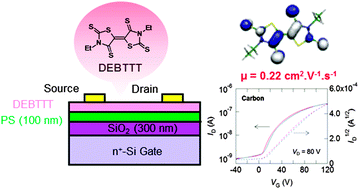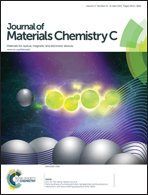Air-stable n-channel organic field-effect transistors based on a sulfur rich π-electron acceptor†
Abstract
Thin-film and single-crystal n-channel organic field-effect transistors are built from the sulfur rich π-electron acceptor, (E)-3,3′-diethyl-5,5′-bithiazolidinylidene-2,4,2′,4′-tetrathione (DEBTTT). Different source and drain electrode materials are investigated: gold, the conducting charge transfer salt (tetrathiafulvalene)(tetracyanoquinodimethane), and carbon paste. Regardless of the nature of the electrodes, air-stable n-channel transistors have been obtained. Single crystals exhibit a higher performance than the thin-film transistors with a mobility of up to 0.22 cm2 V−1 s−1. These thin-film and single-crystal devices exhibit excellent long-term stability as demonstrated by the mobility measured during several weeks. The high mobility and air stability are ascribed to the characteristic three-dimensional S–S network coming from the thioketone sulfur atoms.


 Please wait while we load your content...
Please wait while we load your content...